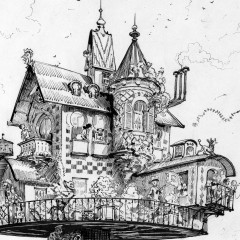Challenging Urban Design: Cambodian Temple-Inspired Home
The ancient ruins of Angkor Wat – the largest religious temple in the world, have inspired Sydney architect Drew Heath to create a house inspired by its archaic wild beauty. Just last month the unique construction won the 2013 National Award for Architecture in the residential category. Dubbed the venerable Irish name Tír na nÓg (“land of youth”), the building mimics the overgrown outlying of the fist Hindu temple. Once a worker’s cottage, today turned into a magnificent construction – the dwelling received Atralia’s most prestigious acknowledgement for exceptional design the 2013 Wilkinson Award for Residential Architecture from the NSW Australian Institute of Architects. Situated in McMahon’s Point – one of Sydney’s most prominent suburbs, Tír na nÓg is an extraordinary example of green urban design. Situated on a quiet street in one of Sydney’s most luxurious suburbs, Tír na nÓg boasts natural bamboo fences and thick foliage to recreate the abandoned beauty of Angkor Wat – the temple lost in the jungle’s heart. Just like the ancient city, the property seems lost in the omnibus greenery. Drew Heath, the designer of the building and owner of Drew Heath Architects, was so fascinated by the Cambodia’s top tourist attraction that he decided to take on the challenge of recreating the solitude of the forgotten ruins in one of Sydney’s most densely populated suburbs – McMahon’s Point. Despite the ambitiousness of the project both jury and public agreed he has succeeded. With its unique floor plan and greenery overflowing the landscape, the house looks both insulated from the rest of the suburb and like an inseparable part of it. The home features several bedrooms and sleeping areas which can host up to 12 people. The old cottage’s backyard has been turned into a sunlit summer pavilion connected to the main building via a central garden. Tír na nÓg’s kitchen is spacious and can be further extended to the garden thanks to the floor-to-ceiling sliding glass panels. It also connects to a contemporary reading room. Indoor and outdoor spaces (including the garden, the bamboo fences and the rooms) all tumble over 12 different levels making the layered design of the building truly extraordinary. With natural sunlight penetrating every level of the house and the unique garden-centred arrangement along with the summer/ winter bathrooms make Tír na nÓg stands to prove why Australia’s exceptional urban architecture is world-widely recognised. Challenging urban design should always be...
Small Apartment – Big Design Statement
What’s the biggest impulse purchase you have ever made? A TV, a car? New York shopping expert and owner of Fab – online retail store, Bradford Shellhammer has surpassed even his own biggest expectations by purchasing an entire apartment on a whim. Having honed his eye to instantly recognise objects of value, he is rightfully considered a true shopping guru but buying a property just like that? Does this border with madness? “We walked in and I had this very emotional reaction. I felt something.” explains Shellhammer So he submitted a bid for the small New York apartment. Surprisingly, it got accepted and Bradford and his husband acquired the property. However, this impulse purchase of a small apartment turned out to be one of the best investments the couple has made. Since the property was recently renovated by the previous owners, Shellhammer got to just swoop in and start decorating. Do the “fun stuff” as the shopping expert said. By the looks of it, the couple had a great time picking out wall colours, the art and home accessories. While the apartment is obviously small and the guys have quite a lot of belongings on display, everything just fits in. From the grocery shopping bags to the drag-queen portraits by Andy Warhol each single object manifests its own character. What’s So Unusual About This Small Apartment Decoration? It’s simple, unlike most small living spaces this one is decorated in bold dark tones. The myth that tiny areas should be painted in whites and neutrals has been debunked. The living room walls are in Pigeon Gray by Benjamin Moore whereas the predominant cool yet vibrant colours on the furniture jazz up the room décor. The word moderation certainly doesn’t describe Shellhammer’s personality as there is barely a free undecorated inch in the entire space. Still, it looks just fabulous! The small bathroom, the bedroom and the dining area are just as extraordinary as the living space. With intricate portraits and objets d’art, geometrical elements and lots of open shelving, every room in the dazzling apartment has its unique surprise element. Compared to the rest of the appartment, the bedroom seems rather modestly decorated but the mood certainly resonates with the design scheme of the property. ...
10 Tips For Buying Art Prints
Museum-grade digital art prints are a classy way to buy art on a budget. Master digital printmaker and founder of Printism.com.au, Roger Saddington, offers his top tips for using art prints in your home. 1. Put the cart before the horse If possible, wait until you’ve bought your art before painting the walls. It’s much easier to paint the wall later than to find the perfect art piece in exactly the right colour. 2. Don’t worry about who the artist is The world is brimming with truly excellent artists who simply can’t be accommodated in the overcrowded upper echelons of the art world. Unless you’ve got huge amounts of money to spend on a ‘name’, concentrate on the ‘great unknowns’ that catch your eye. 3. Buy for love Buying art for investment is a risky, long-term enterprise, with no guarantees. Concentrate on affordable art that will give you pleasure over the next decade and save your real money for blue-chip shares, a much safer investment. 4. Meaningful looks Search for art with authentic detail or a meaningful subject. These are far more important than the colour palate. The symbolism or intricacy of a carefully made work will give you years of pleasure long after the joy of matching your existing curtain colour has faded. 5. Develop a theory If you buy a beautiful print, your family and friends are sure to comment. Think about what attracted you to this image. Perhaps the subject has personal meaning or the light reminds you of a favourite place. What do you think the artist was trying to achieve? Put your thoughts forward in conversation to really get people talking about and admiring your art (and your taste). 6. Size does matter Don’t try to fill a big wall with two, three or four smaller pieces. If you have a large wall in your home, rejoice in the opportunity to make a stunning statement. High quality ‘large format’ print material is now coming onto the market at prices that were unthinkable ten years ago. The right subject, presented at the proper scale, can make you whole home sing. 7. Look for painterly art Clichéd photographs of international tourist destinations are multiplying like rabbits within the department stores of the world. Look for prints with an effect you’ve not seen before. Images that feature a ‘hand-made’ technique will age much better than straight photography. 8. Beware of wallpaper art Likewise, the production line art studios of China have spawned a plethora of ‘oil on canvas’ paintings often found in suburban framing galleries and market stalls. Many of these are simply patches of colour with...
House of Bottles
There are 1001 ways to recycle and help protect the environment. From separating your residential waste in different containers to using energy saving appliances. However, some home-owners use their creativity to build houses from the most unusual materials. While the concept of using bottles to make dwellings is not a novelty, I am fascinated with the patience and determination of one person. Tito Ingenieri an Argentinian artist has utilised over six million recycled glass bottles to build a magnificent home for himself and his pet Captain Nemo. The incredible structure is known as ‘Casa de Botellas’ or ‘House of Bottles’. The artist has been working on this project for 21 years. Years of gathering glass bottles, cleaning them and arranging them layer after layer until the entire unit was complete. In an interview for Argentina Independent, the 57-year-old sculptor states: ‘You could say that I’m one of time’s castaways. I am an art labourer and I didn’t have a house so I decided to make one‘ Just like that Tito made the decision to build what is by far one of the most extraordinary homes I have ever seen. The persistence and love with which the artist has gathered each bottle and then laid it so that it fits the gigantic puzzle that is ‘Casa de Botellas’. However, the bottle structure is by far not the only inspiring thing about his home. Everyday items turned into enchanted art pieces lurk behind every corner of the establishment. After 21 years of recycling, upcycling and manual labour, Tito’s own home is now open for visitors. As you can see from the pictures below its interior is even more dazzling than the exterior. There is only one thing we would like to remind. Cleaning glass bottles is hard enough on its own but when you throw in that they have been left to the mercy of nature elements, it gets even more difficult. Making the Bottle House With a framework made of re-claimed iron, the structure has an unusual shape which totally corresponds with Ingenieri’s personality and style. Just like the rest of the construction is created from re-purposed materials like the glass bottles, the main framework incorporates 50-year-old wagon wheels and even port-hole windows. Thanks to the stable foundation, the aggregated pressure from the bottles is relieved preventing the bottles from shattering into million pieces. Tito’s bottle house not only showcases his creativity and vision, it also stands as a monument of community spirit. Most of the bottles – different in shape, colour and style, are donated by local clubs and even authorities. Beer bottles find their rightful spot right next...
The Oldest Rotating House in the World
Nowadays, rotating houses are not an innovation. There have been many fantastic examples around the world, including the magnificent Girasole in Canberra. It is no secret that its owner and designer was inspired by Italian architecture and design. Not many, however, know that our Australian Girasole’s predecessor carries the same name and was built almost 63 years ago. Villa Girasole is the oldest rotating house in the world designed by a local navy engineer, Angelo Invernizzi. Situated near Verona, Italy, the house follows the path of the sun in a circular motion. Translated from Italian, the word girasole means sunflower. An appropriate name for the house which follows the sun. The idea behind the creation of the first-of-its-kind rotating house is simple – to harness solar energy. Modern buildings use solar panels to transform it into energy. The implementation of the ambitious project took six years from 1929 to 1935. While it might seem too long for the construction of a house, we all know Girasole was no ordinary dwelling. Its unique for that era design and purpose required the use of advanced technologies. The First Rotating House Technology Girasole consists of two main body parts – a circular base (44 meter diameter) and an L-shaped rotational block. In the centre you will see a beautiful 40-meter-high tower described by many as a light-house-type construction. To rotate the 1500 tons structure, Invernizzi created an elegant mechanism powered by two diesel motors. With a speed of 4 mm per second, Girasole completes a full rotation cycle in approximately 9 hours and 20 minutes. Compared to modern rotating houses which can do make a full turn in less than 10 minutes, it might seem like an eternity. However, this is more than enough to follow the leisurely motion of the sun. Despite the genius design and advanced mechanics, each turn leaves signs of wear and tear in the foundation of the building. The vertical shaft grinds deep into the earthbound foundation, thus the very technology which awakens the structure also brings it one step closer to destruction. Today, Girasole is owned by the Invernizzi Foundation and the Swiss Mendrisio Academy of...
















